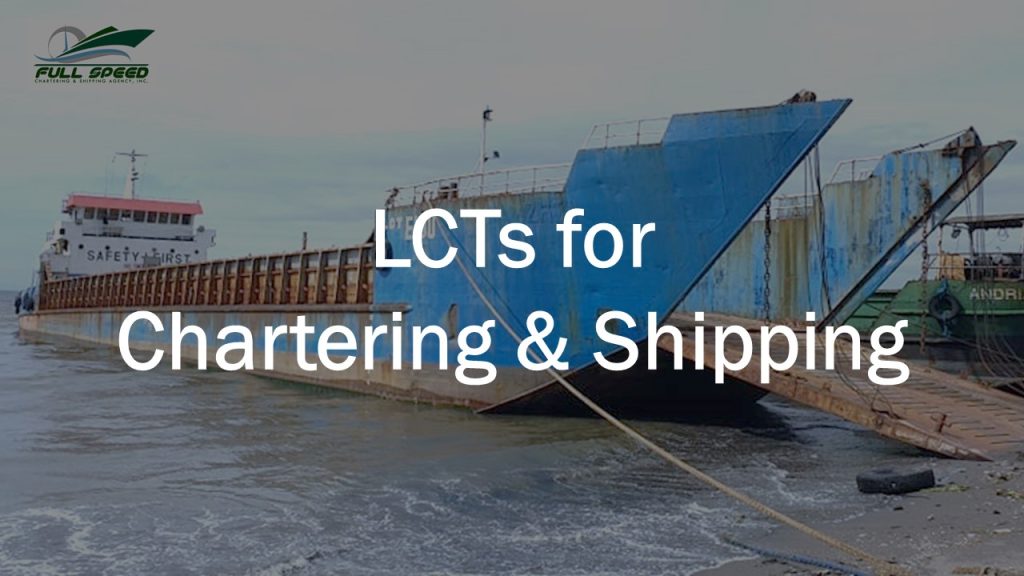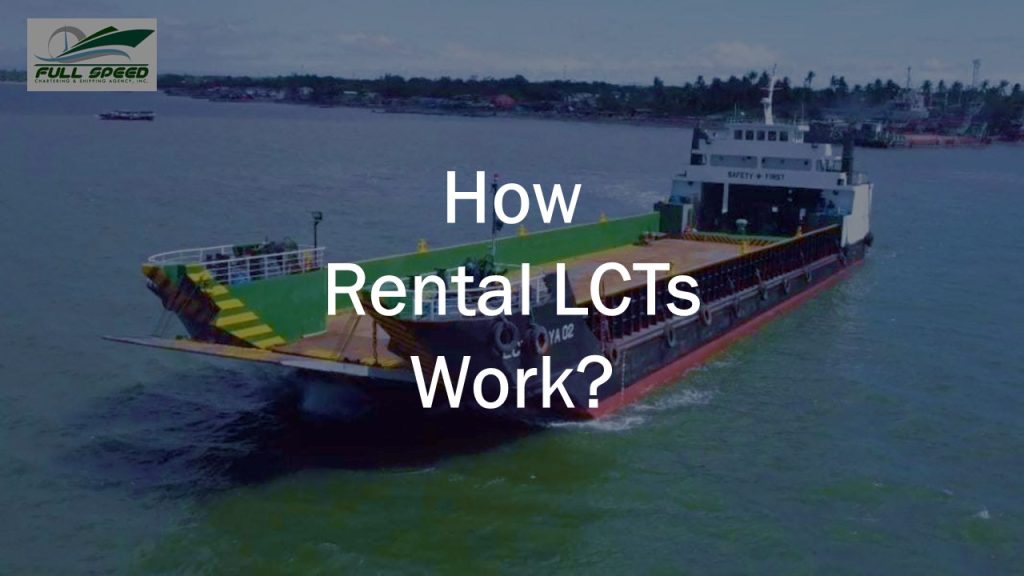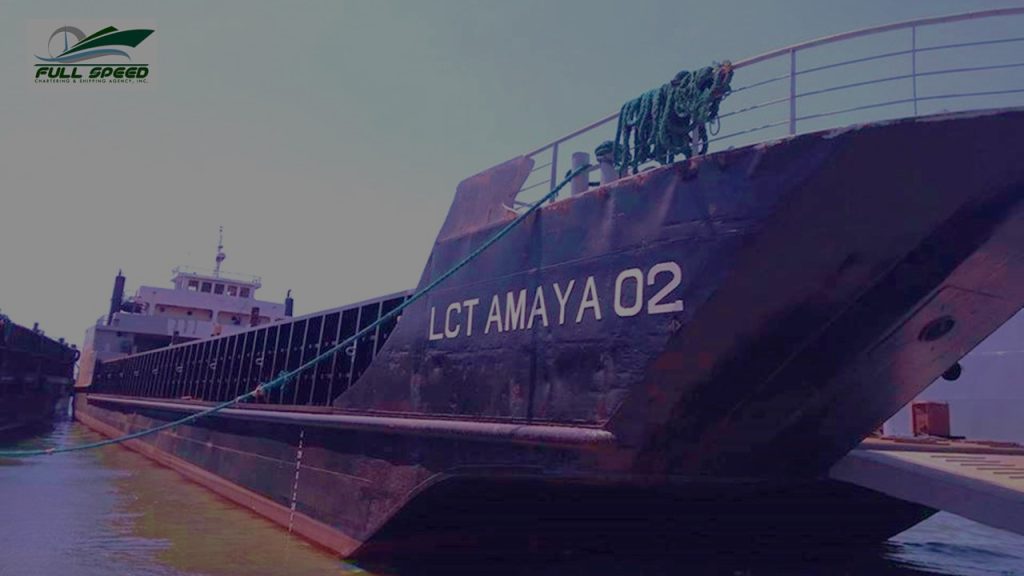Ship-to-ship chartering in the Philippines has emerged as a significant aspect of maritime transport, particularly with the increasing demand for efficient and cost-effective cargo transfer operations. One particular type of vessel that plays a crucial role in this domain is the Landing Craft Transport (LCT). LCTs serve as essential workhorses in facilitating ship-to-ship transfers, carrying various types of cargo ranging from heavy machinery to construction materials.
This article explores the thriving industry of ship-to-ship chartering in the Philippines and delves into how LCTs for rent in the Philippines have become indispensable assets for seamless cargo transfer operations.
Click here to find out about our rental LCTs fleet.
Overview of Ship-to-Ship Chartering in the Philippines
Ship-to-ship chartering in the Philippines has emerged as a crucial aspect of maritime trade and logistics operations in recent years. This practice involves transferring cargo between two vessels at sea, eliminating the need for vessels to enter congested ports. With its strategic location in Southeast Asia and extensive coastline, the Philippines offers favorable conditions for ship-to-ship chartering activities utilizing rental LCTs.
One advantage of ship-to-ship chartering in the Philippines is its ability to accommodate larger vessels that may be too large to enter certain ports. By employing specialized equipment such as floating cranes or barges, cargo can be efficiently transferred from one vessel to another, ensuring timely delivery and reducing operational costs. Additionally, ship-to-ship chartering using rental LCTs enables shippers to bypass port congestion and other logistical challenges that can cause delays or disruptions.
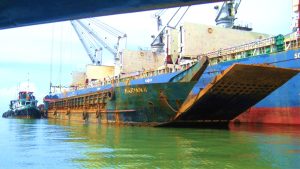
Benefits of Landing Craft Transport (LCT) Services
Landing Craft Transport (LCT) services offer numerous benefits for ship-to-ship chartering in the Philippines. These specialized vessels are designed to transport various types of cargo, equipment, and vehicles from one ship to another or between a ship and the shore. One significant advantage of utilizing rental LCT services is their ability to access shallow waters that larger vessels cannot reach. This makes them ideal for operations in smaller ports or coastal areas that may not have proper docking facilities for larger ships.
Furthermore, rental LCT services provide efficient and cost-effective means of transporting goods. By using rental LCTs for ship-to-ship chartering in the Philippines, companies can avoid the need for additional handling at ports or harbors. Instead, cargo can be directly transferred from one vessel to another without involving multiple terminals or intermediaries.
Types of Cargo Suitable for LCT Chartering
Ship-to-ship chartering in the Philippines, utilizing rental LCT barges, has been gaining popularity as an efficient way to transport various types of cargo. Landing Craft Transport (LCTs) are versatile rental barge vessels that can be easily loaded and unloaded without the use of port infrastructure, making them ideal for island hopping and reaching remote areas. When it comes to deciding which cargo is suitable for LCT chartering, several factors come into play.
First, heavy equipment such as construction machinery, bulldozers, or cranes can be efficiently transported using LCTs for lease in the Philippines. These rental vessels have spacious decks and ramps that allow seamless loading and unloading of heavy machinery, ensuring a smooth operation even in challenging terrain.
Additionally, LCTs are also excellent choices for transporting bulk cargo like aggregates or sand due to their large open deck spaces. Furthermore, rental LCT barges in the Philippines are equipped with ballast tanks, which allow them to adjust their draft, making them adaptable for shallow waters and ensuring safe navigation. This makes them well-suited for transporting goods to remote areas with limited infrastructure.
In addition to heavy equipment and bulk cargo, LCTs for hire in the Philippines can also accommodate various types of vehicles, such as trucks, trailers, and even train carriages. With their wide decks and sturdy construction, these vessels provide a secure platform for the transportation of vehicles over long distances.
On the other hand, for mining operations, LCTs for rent in the Philippines can be used to transport mining equipment, machinery, and minerals, such as ores, to and from remote mining sites. This is particularly beneficial in areas where traditional transportation methods such as roads or railways are not available or feasible. Due to their ability to adjust drafts and navigate shallow waters, LCTs for lease in the Philippines can access rivers, lakes, and coastal areas that may be closer to the mining site. This reduces the need for extensive land-based infrastructure development, saving time and costs associated with building roads or railway networks.
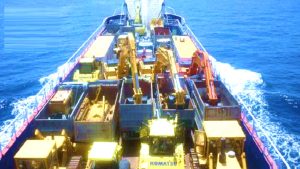
Types of Landing Craft Transport in the Philippines: Description and Capabilities
Ship-to-ship chartering in the Philippines has become increasingly popular for various industries, from construction and oil exploration to trade cargo delivery and disaster response. To efficiently facilitate cargo transportation between vessels, landing craft are essential. These specialized vessels come in different types, each with its own unique features and capabilities.
One type of landing craft for rent in the Philippines is the Roll-On/Roll-Off (Ro-Ro) vessel. This type of craft is designed with ramps at both ends, allowing vehicles and cargo to be rolled on and off easily. Rental Ro-Ro landing craft transports have a large open deck space that can accommodate a wide range of cargo sizes. They are commonly used for transporting trucks, cars, heavy machinery, containers, and bulk materials. With their versatility and quick loading/unloading times, Ro-Ro landing crafts provide efficient ship-to-ship chartering solutions in the Philippines.
Another type of landing craft that is available for rent in the Philippines is the LCT (Landing Craft Tank). Unlike Ro-Ro vessels, rental LCTs are specifically designed to transport tanks and other heavy equipment. These landing craft have a flat deck with a sturdy ramp at the front, allowing for easy loading and unloading of tanks onto shore or other vessels.
LCTs are commonly used by various industries such as construction, mining, and offshore operations that require transporting heavy machinery and equipment.
Ship-to-Ship Chartering in the Philippines: Advantages and Process
Ship-to-ship chartering in the Philippines offers numerous advantages for companies in need of efficient and cost-effective transportation solutions. With its strategic location and extensive coastline, the Philippines serves as a vital hub for international shipping routes. Ship-to-ship chartering using rental LCTs in the Philippines enables vessels to transfer cargo from one ship to another, eliminating the need for intermediaries such as terminals or ports. This process not only saves time but also reduces costs associated with port fees and delays.
The ship-to-ship chartering process in the Philippines involves several key steps. Firstly, both parties involved negotiate and agree on the terms of the charter agreement, including rates, duration, and any additional services required. Once a contract is signed, suitable vessels are selected based on their size, capacity, and compatibility with the type of cargo being transferred.
The next step in the ship-to-ship chartering process is to ensure that all necessary permits and regulatory requirements are met. This includes obtaining clearance from relevant government authorities, such as the Philippine Coast Guard and the Maritime Industry Authority. Once all permits are secured, preparations for the cargo transfer begin. This involves coordinating logistics, arranging for appropriate equipment like cranes or pumps, and ensuring safety measures are in place to prevent any accidents or spills during the operation.
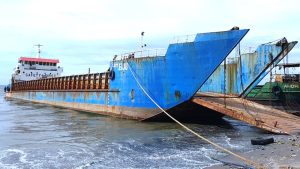
Challenges and Regulations in Ship-to-Ship Chartering
Ship-to-ship chartering in the Philippines presents a unique set of challenges and regulations that companies must navigate. One of the primary challenges is ensuring safe and efficient operations when transferring cargo between two vessels. This process requires careful coordination, skilled Filipino personnel, and adherence to international safety standards to avoid accidents or spills that could have disastrous consequences for both the environment and human life.
In addition to safety concerns, there are also strict regulations in place governing ship-to-ship chartering in the Philippines. Companies must comply with international maritime laws as well as local regulations enforced by government agencies such as the Philippine Coast Guard and the Maritime Industry Authority (MARINA). These regulations cover various aspects of ship-to-ship operations, including licensing requirements, equipment standards, crew qualifications, and environmental protection measures. Compliance with these regulations not only ensures smooth operations but also helps maintain a level playing field among industry players.
Popular Routes and Destinations of Ship-to-Ship Chartering in the Philippines
Ship-to-ship chartering in the Philippines has gained significant popularity among construction and mining businesses due to the country’s strategic location, vast natural resources, and growing infrastructure projects. One of the most popular routes for ship-to-ship chartering is from Manila, the capital city of the Philippines, to various destinations in Mindanao. This route is particularly favored by construction companies involved in large-scale projects as it allows for efficient transport of heavy machinery and materials.
Another highly sought-after route for ship-to-ship chartering is from Cebu, a major hub in the central Philippines, to the Caraga region. Caraga region’s rich mineral reserves make it an attractive destination for mining businesses looking to extract valuable resources such as ore, nickel, and copper. Ship-to-ship chartering utilizing rental LCTs provides a cost-effective means of transporting these minerals from the Caraga region to other parts of the country or even internationally.
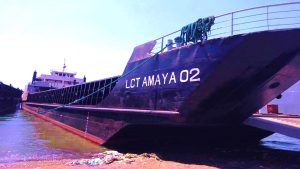
Case Studies: Successful LCT Charters in the Philippines
In recent years, ship-to-ship chartering in the Philippines has emerged as a game-changer for the country’s mining and construction industries. The long-term lease of Landing Craft Tankers (LCTs) has proven to be highly successful in transporting heavy equipment, machinery, and supplies to remote locations with limited infrastructure. Two noteworthy case studies showcase the efficiency and reliability of rental LCT charters in this sector.
The first case study revolves around a major mining project on an island situated off the coast of Mindanao. With rough seas making it impossible for large vessels to dock directly at the site, rental LCT charters became the ideal solution. By utilizing multiple LCTs for rent in Mindanao, the project management team successfully transported heavy drilling machines, excavators, and other essential equipment from a nearby port directly to the island’s shore. The LCT charters proved to be highly effective in navigating the challenging waters and delivering the equipment safely and efficiently. The project was able to proceed without any delays or disruptions, thanks to the reliable transportation provided by the LCTs for lease in the Philippines.
In addition to the mining project, another case study highlights the use of rental LCT charters in transporting construction materials during dredging operations. In this case, a coastal city underwent extensive dredging operations to deepen its harbor and accommodate larger ships. The project required a vast amount of construction materials, such as rocks, sand, and cement, to be transported from the mainland to the harbor.
The project management team decided to utilize LCT charters due to their ability to navigate shallow waters and transport heavy loads efficiently. This proved instrumental in overcoming the logistical challenges posed by the dredging operation.
Do You Need Rental Landing Craft Transport in the Philippines?
Full Speed Chartering and Shipping Agency, Inc. is your one-stop solution for all your rental landing craft transport needs for ship-to-ship chartering in the Philippines. With a fleet of well-maintained and cost-effective LCTs, we offer reliable and efficient transportation services to cater to various industries such as construction, mining, oil and gas, and more.
- Email us: info@fullspeedchartering.com
- Call our 24-hour hotline: +63 939 375 3224
- Viber: +63 939 375 3224
- WhatsApp: +63 939 375 3224
- Facebook Messenger: Click here
- Click here to inquire
Our rental LCTs are designed specifically for landing cargo on remote or shallow beaches, making them perfect for coastal projects or delivering supplies to islands with limited infrastructure. Equipped with state-of-the-art navigation systems and experienced crew members, our vessels can navigate through challenging waters safely and efficiently. Whether you need to transport heavy equipment, construction materials, or bulk cargo, our LCTs for hire in the Philippines are capable of handling them all.
At Full Speed Chartering and Shipping Agency, Inc., we understand the unique challenges and demands of the industries we serve. With years of experience in the maritime industry, we have built a reputation for providing reliable and efficient transportation solutions.
Our rental LCTs (landing craft tanks) in the Philippines are the most versatile vessels and are equipped with powerful engines that allow them to operate at full speed, even in challenging conditions.
Final Word: Future Prospects and Growth Potential of Ship-to-Ship Chartering in the Philippines
In conclusion, the future prospects and growth potential of ship-to-ship chartering in the Philippines are promising. The country’s strategic location, booming maritime industry, and increasing demand for efficient cargo transfer make it an ideal ship-to-ship rental service market. With advancements in technology and infrastructure development, the Philippines has the opportunity to become a leading hub for ship-to-ship operations in Southeast Asia.
However, to fully capitalize on this potential, it is crucial for stakeholders to collaborate and invest in enhancing port facilities and implementing industry best practices. By doing so, we can maximize efficiency, improve safety standards, and ensure sustainable growth for ship-to-ship chartering in Luzon, Visayas, and Mindanao.
With the increasing demand for efficient and cost-effective transportation of goods and resources, ship-to-ship chartering offers a viable solution for mining, engineering, construction, manufacturing, oil and gas, and other industrial sectors.
Additionally, the advancements in infrastructure and technology further enhance the capabilities of ship-to-ship chartering in the Philippines. As more Filipino engineering-allied businesses recognize the benefits and advantages of this mode of transport, we can expect to see continued growth and development in the industry.
It is crucial for engineering and logistics companies to seize these opportunities and invest in this growing sector to fully harness its potential for economic progress and prosperity in the country.

